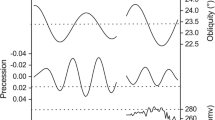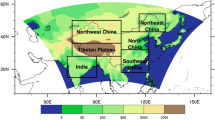Abstract
The climate and vegetation patterns of the middle Holocene (6000 years ago; 6 ka) over Northern Africa are simulated using a fully-synchronous climate and dynamical vegetation model. The coupled model predicts a northward shift in tropical rainforest and tropical deciduous forest vegetation by about 5 degrees of latitude, and an increase in grassland at the present-day simulated Saharan boundaries. The northward expansion of vegetation over North Africa at 6 ka is initiated by an orbitally-induced amplification of the summer monsoon, and enhanced by feedback effects induced by the vegetation. These combined processes lead to a major reduction in Saharan desert area at 6 ka relative to present-day of about 50%. However, as shown in previous asynchronous modelling studies, the coupled climate/vegetation model does not fully reproduce the vegetation patterns inferred from palaeoenvironmental records, which suggest that steppe vegetation may have existed across most of Northern Africa. Orbital changes produce an intensification of monsoonal precipitation during the peak rainy season (July to September), whilst vegetation feedbacks, in addition to producing further increases in the peak intensity, play an important role in extending the rainy season from May/June through to November. The orbitally induced increases in precipitation are relatively uniform from west to east, in contrast to vegetation feedback-induced increases in precipitation which are concentrated in western North Africa. Annual-average precipitation increases caused by vegetation feedbacks are simulated to be of similar importance to orbital effects in the west, whilst they are relatively unimportant farther to the east. The orbital, vegetation and combined orbital and vegetation-induced changes in climate, from the simulations presented in this study, have been compared with results from previous modelling studies over the appropriate North African domain. Consequently, the important role of vegetation parametrizations in determining the magnitude of vegetation feedbacks has been illustrated. Further modelling studies which include the effects of changes in ocean temperature and changes in soil properties may be needed, along with additional observations, to resolve the discrepancy between model predictions of vegetation and palaeorecords for North Africa.
Similar content being viewed by others
Author information
Authors and Affiliations
Additional information
Received: 15 June 1999 / Accepted: 14 December 1999
Rights and permissions
About this article
Cite this article
Doherty, R., Kutzbach, J., Foley, J. et al. Fully coupled climate/dynamical vegetation model simulations over Northern Africa during the mid-Holocene. Climate Dynamics 16, 561–573 (2000). https://doi.org/10.1007/s003820000065
Issue Date:
DOI: https://doi.org/10.1007/s003820000065




